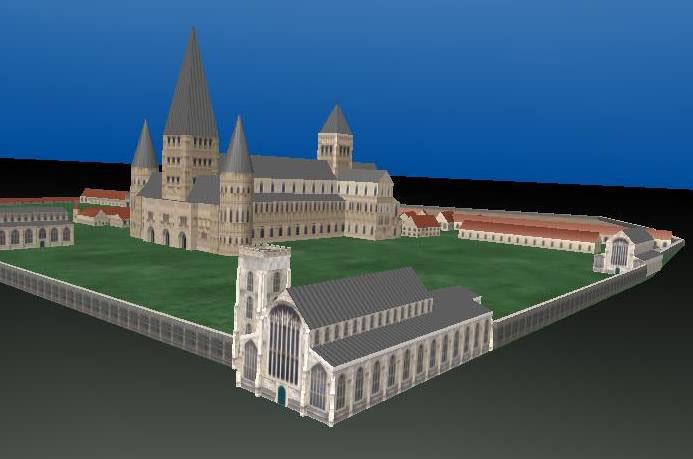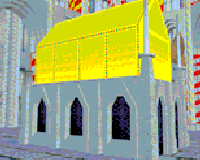 |
 |

A mini version of the model can be viewed by clicking on the image above. But:- Internet browsers such as Internet Explorer cannot read Virtual Reality models without downloading a VR plug-in. These plug-ins tend to get removed or moved to new addresses fairly often. However, in November 2013, these two are still available, and seem to work in Windows 7: Flux Player can be downloaded from Media Machines ,containing both Flux Player and Flux Studio in single installer.
Alternatively, the modern Cortona plug-in is available from here:
If you are using Windows 95, you may want to try this:
The Abbey of St Edmund VR project was sponsored by Greene King Plc.
The VHS video is no longer sold, but you can see a short version on YouTube here:- The Virtual Abbey of Bury St Edmunds
The full version can also be seen on YouTube here:- |
Created in 1998
In July 1998, St Edmundsbury Borough Council launched the Virtual Abbey in the following terms:
"For the first time in 450 years it is possible to visit the Mediaeval Abbey of St Edmund. This mighty church that once dominated the lives of local people has stood in ruins for nearly five centuries, but with the help of a virtual reality model you can be among the first people to explore it since the 16th Century.
What can be seen is the very raison d'etre of the town of Bury St Edmunds - the shrine of the martyred Saxon King Edmund, killed by marauding Danes in 869 AD. For centuries after his body was laid to rest in the town, pilgrims from throughout the world came to worship and the Abbey grew in strength and wealth. Edmund was a patron saint of England, until the more martial St George replaced him. His feast day is still celebrated in Bury St Edmunds on 20th November each year.
As a destination for pilgrims, the town was second only to Santiago de Compostela in Northern Spain. Pilgrim's badges could be bought in the market place by those who had successfully made the journey to Bury St Edmunds. Our model shows the market place, and takes you from there down the Pilgrim's Route to the Abbey.
On the dissolution of the monasteries by Henry VIII in the 16th Century, the Abbey was dismantled and fell into ruin. The current day St Edmundsbury Cathedral and its elegant neighbour, St Mary's Church, are all that remain of the mighty complex of church buildings that once stood alongside Angel Hill - or they were, until now.
The model is the most advanced project of its kind in the United Kingdom, and marks a new era in heritage interpretation.
How did St Edmundsbury Borough Council set about creating a model of a building that no longer exists?
But what did the Abbey look like?
When we do this, we come up with two examples which provide many of the clues we need: Ely Cathedral and Norwich Cathedral. It is likely that the same masons worked on all three sites, so we can reasonably expect a high degree of stylistic continuity between them. Still standing in Bury St Edmunds is the original Norman Tower, the pilgrims' gateway to the Abbey, and this gives us yet more clues as to the style of building. This kind of evidence is called analogous or parallel evidence.
With so little left of the Abbey of St Edmund, what evidence do we have?
In addition to these clues, we also need to consider written accounts, such as the Chronicles of Brother Jocelin of Brakelond which were recorded in the time of Samson, the greatest of the Abbots. Other books and personal accounts from the Abbey are to be found in libraries across the country.
Artefacts found by archaeologists at the site also help to establish the likely use of certain buildings: a cooking pot, for example, would suggest a kitchen or cooking area.
All these techniques can be used to model the Mediaeval town as it might have looked in the 1400s. The street plan, and even the size of many of the building plots are known. The detail can then be added, based on surviving buildings from the period which are found in this area.
What is Virtual Reality?
The greatest feature of VR in a heritage context is its ability to give visitors access -
|

|
How is it used? Virtual reality has been in use for decades. Flight simulators used for military and commercial training were one of the earliest applications. Then virtual technology took the games market by storm. Traditionally, it involved headsets or helmets that covered the ears and eyes and created the illusion that the wearer had really entered a virtual world. Now, however, wide screen cinema displays allow groups of people to share a VR experience first hand. Whilst public interest has died down, VR is hard at work in the industrial world, and used to plan new buildings before heavy capital investments are made. Moreover, technology has moved on and there are other options for enjoying VR which include:
The information needed to rebuild the Abbey was collected by St Edmundsbury Borough Council Museums Service. However, the modelling was carried out in Melton Mowbray by PERA, the first commercial VR centre in Britain. PERA's many previous projects include factory layouts for Norcroft; architectural visualisations for Barclaycard office buildings and Vinten Broadcasting (in Bury St Edmunds), and a feasibility study for a virtual library for the British Library. Some of this work is to be published as case studies by the Department of Trade and Industry's UKVR Forum. An important asset of a virtual attraction is that it could be constantly updated. This means that the developers could include new buildings, features, or activities to the Abbey at any time. The model you see on display here is by no means finished. They could add:
Present Position |
| Go to Monastic Homepage | Last Updated 12th November, 2013. YouTube links added June 2013. | Go to Home Page |